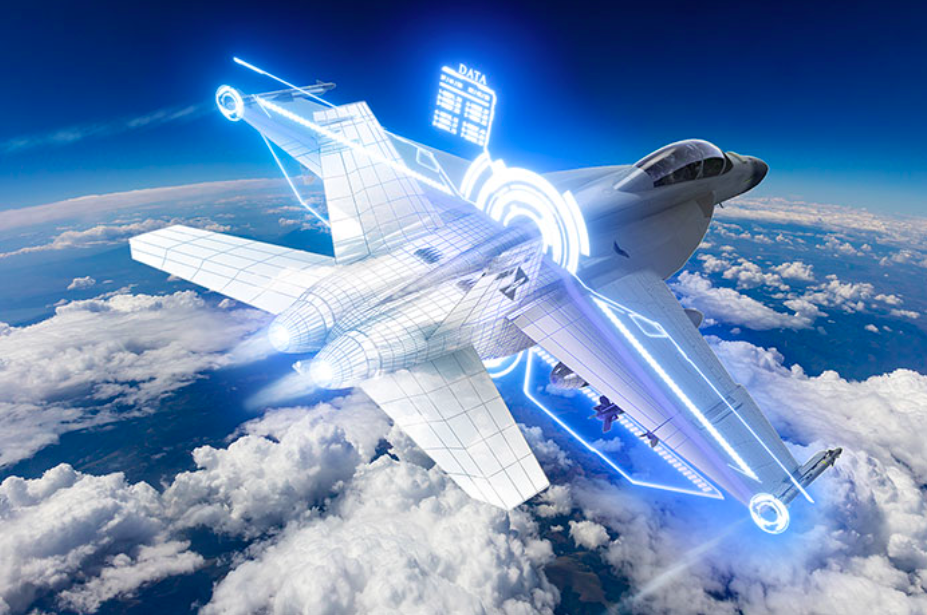
Digital design/engineering is central to the Air Force’s Next Generation Air Dominance (NGAD) program. Raytheon I&S image.
WASHINGTON: Digital ‘transformation’ is allowing each uniformed service to determine whether new weapon systems can integrate smoothly into joint operations — a foundational requirement for implementing DoD’s Joint All Domain Command and Control (JADC2) strategy, say senior Air and Space Force officials.
From DoD’s top-level perspective, “all your systems have to play together,” Mike Roberts, director of the Space Rapid Capabilities Office (Space RCO) said yesterday. “All the data has to be able to be pushed around and, and digital engineering allows you to make sure that happens.”
Roberts was speaking — with Air Force Chief Architect Preston Dunlap; William Bailey, Air Force deputy assistant secretary for acquisition integration; Kristen Baldwin, Air Force deputy assistant secretary for science, technology & engineering — to the Potomac Officers Club seminar on digital acquisition.
Digital acquisition is shorthand for applying to weapon system development the kind of highly computerized design, engineering and manufacturing processes commonly used in commercial industry, such as the automotive sector, to churn out new and improved models on a rapid basis. The term also covers finding ways to speed the often glacial pace of DoD contracting, especially for software-based systems.
The digital revolution is “critical to being able to maintain our advantage over peer competitors,” Baldwin stressed. “Digital transformation is really essential, and it’s really a national and economic security imperative.”
Getting the Recipe Right
“It’s not simply enough to have excellent, call it ingredients, but you actually have to pull ingredients into a recipe to be able to enjoy the food, or achieve the the end state that you’re after,” Dunlap explained. “We need horizontal integration to be able to actually bring the ingredients, or the platforms and systems and software that we have, together to be able to achieve the end states we need.”
Dunlap, a key player in the development of the Air Force’s Advanced Battle Management System (AMBS) family of systems aimed at supporting JADC2, said there are three key mission focuses across the Air and Space Forces. (Space Force falls under the Department of the Air Force, in the same way the Marine Corps falls under the Department of the Navy.)
“Number one is getting after information advantage and decision superiority — to understand the scope so that we can hopefully avoid conflict. But, if we do (go to war), achieve success in conflict on the operational level,” he said.
Information advantage is one of the four key tenets of DoD’s new Joint Warfighting Concept (JWC) for prosecuting All Domain Operations against countries such as Russia and China. While not well defined — at least in public, although the Army is moving out on developing information advantage doctrine — the concept in effect comes down to US commanders getting better information faster than their opponents.
Dunlap explained that the second focus is “looking at integrating capabilities” for “distributed operations and Agile Combat Employment that’s defensible and sustainable.”
Agile Combat Employment (ACE), refers to the Air Force capability to operate from dispersed locations and limit its basing and operational footprint, for example through being able to land aircraft where there are no improved runways — and it is a key Air Force tenant for implementing the JWC.
Finally, he said, the goal “at the tactical level” is “getting really good at rapid kill chains, and that’s where things like Joint All Domain Command and Control, or JADC2, fits in, or ABMS fits in, to the scheme as well.”
To accomplish those three missions, Dunlap elaborated, the Air and Space Forces are working on:
- Data, including mobility of data across classification levels: “getting data right, for the boardroom and the battlefields, making decisions effectively and successfully at speeds.”
- AI. “We’re making AI real … We are making progress, not only on systems, but also for more strategic applications of AI.”
- Networks. “We’re looking to overhaul our networks, especially classified networks, and use your devices to put us into the modern age that we need, just for day-to-day operations as COVID showed us here, but also in distributed operations overseas.”
- Integrating ISR. “We’re looking to tie it together and integrate space, air, cyber intelligence, surveillance and reconnaissance: is our data and information to be able to make sense of that?”






















